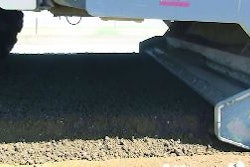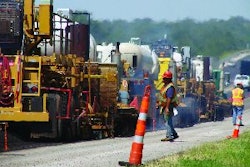Full Depth Reclamation with a cement additive has been a preservation solution NCDOT has used to maintain low-volume rural roads for years, and Chris McGee, District #2 Engineer for NCDOT's Division 6, expanded that option in the spring of 2008 by using an emulsion additive on an FDR project in Johnston County.
Baileys X-rds is a collector road with an average daily traffic county of approximately 1,000 vehicles. The farm-to-market road does support a fair amount of truck traffic as well, serving two small trucking companies along with heavy farm equipment. Located south of Raleigh near Dunn, NC, the 23-foot-wide road had severe transverse cracking approximately every 10 feet throughout.
The cracks were from ¼- to ½-inch wide with potholes developing in multiple locations. Several farms and subdivisions are located along this road and it also serves as a connector road for traffic.
A 1.3-mile section of the road between Chic Ennis Road and Ebenezer Church Road was chosen for reconstruction. Sections north and south of the reconstruction project were overlaid with 1.5 inches of HMA only.
"The crack filling followed by an HMA overlay on the north and south sections of Baileys is a typical maintenance approach we take for roads of this type," notes McGee. "The center portion of the road was showing some severe block cracking problems every 30 to 40 feet, similar to what you would find on a concrete road that has an asphalt overlay. Since there was no concrete under the existing asphalt, we wanted to remix the subgrade material and we wanted to see how an emulsion additive versus a cement additive would perform in helping to stabilize the road material."
Full Depth Reclamation (FDR) with engineered emulsion from SemMaterials was chosen as the solution for reconstruction of Baileys X-rds. Successful engineered emulsion FDR jobs entail the use of high performance specifications, engineered mix design and preliminary road evaluations.
An engineered emulsion FDR project provides a flexible, bound and structurally upgraded base that is moisture, fatigue and temperature resistant. The chemistry and engineered design allow for a quick return to traffic due to high early strength of the new base and enhanced dispersion of the asphalt for coating.
Prior to construction, testing was performed on the Baileys X-rds project to help ensure a quality project. Sand equivalency and washed gradation were performed on the blend of material and it was determined that the road was an engineered emulsion candidate. Then a boring and soil analysis was performed by TriMat Materials Testing Inc. out of Raleigh to a depth of 5 feet at six locations per lane, as well as Dynamic Cone Penetrometer (DCP) to determine the in-place strength of the subgrade.
Evaluation of the soil analysis and DCP data revealed a 300 foot section of road with unsuitable material that was replaced with GAB (granulized aggregate base) prior to construction.Once compatibility tests and subgrade tests were deemed acceptable, material was gathered for mix design by SemMaterials.
Cores were taken to a depth of 7.25 inches every 400 feet per side, and staggered to facilitate enough material for an engineered mix design and to check uniformity of in-place materials. The road averaged 3.9 inches of asphalt over a sandy base. The sand was classified by TriMat as well-graded sand with clay to poorly-graded sand with clay.
FDR executed
Slurry Pavers Inc., headquartered in Virginia, performed the FDR for Baileys X-rds in April of 2008. During construction the road was closed, except to local traffic, due to the ease of rerouting traffic and simplifying the construction process.
The road was pulverized down 8 inches with a Wirtgen 2500 reclaimer, and then adjusted profile to 2 percent slope with a CAT 12-H motor grader with GPS control. Pulverization before injection of emulsion aided in meeting gradation requirements. It also allowed for profiling and made moisture monitoring more accessible.
After proper moisture of the in-place materials was reached, the reclaimer made three passes at 7.25 inches deep, injecting 4 percent of the cationic slow setting emulsion into the full width of the road. Each pass was 8 feet wide, overlapping 6 inches, and approximately 630 feet in length. Slurry Pavers used approximately 57,000 gallons of engineered emulsion to stabilize approximately 95,381 cubic feet of material.
"It was a pretty smooth job for us," says Larry Roberts FDR/Soil Stabilization Division Manager for Slurry Pavers. "The only problem we ran into was that the existing asphalt was little on the abrasive side and we ended up going through a lot of teeth on our cutting drum." As Roberts noted, the company does a lot of FDR work with cement and lime additives, but would like to do more with emulsion additives. Slurry Pavers' Baileys X-rds crew completed their work in five days.
The reclaimer was followed closely by two CP-563E pad foot rollers to achieve deep compaction. The motor grader followed behind the pad foot rollers to remove the indentations and smooth the surface before final compaction.
Then a Roscoe Tru-Pac 915 rubber-tire followed by an Ingersoll Rand DD70HF steel wheel were used for final compaction.
Normally after final compaction a road can be opened to traffic with a successful proof roll. However, with the ease of diverting traffic, the road was left closed during construction. A week later, 2 inches of HMA was placed on top of the stabilized base by Barnhill Contracting Company.
Field testing was performed during construction for quality assurance of the final product. The tests performed were moisture content, nuclear and modified proctor for density, gradation and depth of reclamation.
In-place moisture was performed ahead of injection of emulsion to make sure moisture was within +/- 1 percent of design moisture, which was determined to be 2.3 percent. This was later adjusted to 3-4 percent moisture based on coating of the materials in field. The increased moisture helped with coating and compaction.
Modified proctor was performed (ASTM D1557, Method C) approximately every 600 feet. Moisture was taken from each proctor sample so dry density could be calculated.
The dry density average was 122 pcf. The nuclear gauge, in direct transmission mode, was performed in five locations per emulsion truck load (approximately 630 feet). The moisture content on the nuclear gauge had to be corrected since it was reading 2-3 times the moisture of what was actually in the material.
A correction factor was determined early on by comparing manual moisture tests to nuclear gauge readings. The nuclear gauge readings were used in conjunction with modified proctor to determine compaction. The modified proctor results were considered to be optimum density.
Compaction was required to be a minimum of 97 percent (nuke gauge dry density/modified proctor dry density). All compaction was greater than 97 percent, with most around 100 percent.
Gradation was checked throughout the process to make sure 98 percent of the blend passed the 2-inch sieve. Also, the depth was monitored with every pass of the reclaimer.
Yield was measured by depth, length and width of reclaimed material, the emulsion tanker ticket and density. The majority of the road had a yield that ranged from 3.9 to 4.1 percent emulsion. In some sandier areas emulsion was adjusted up to 4.4 percent to achieve proper coating, due to higher fines.
The preconstruction cracking and fatigue issues were corrected with the stabilized base with engineered emulsion. Other sections of Baileys X-rds that were not reclaimed were overlaid with 1.5 inches HMA only. Within a month, the transverse cracking reflected through in the areas where FDR was not performed. To date, there are no distresses in the FDR section.
As for McGee's assessment of the $330,000 project, he says, "Unlike the typical overlays we place on a road like Baileys (both ends were treated in this fashion), which tend to show reflective cracking shortly after they've been completed, the FDR with emulsion we decided to use on the center portion of the road is really performing well. We now know it's another option we have in maintaining and preserving our road system."



















